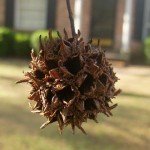Sweetgum , American Sweetgum
Liquidambar styraciflua L.
Hamamelidaceae (Witch-hazel family)
Description
Sweetgum is a large, native tree in the Witch-Hazel family. A warm-season perennial, it can grow up to 150 feet or 47.5 m tall. Its bark is brown to gray, very rough, and may have deep furrows and rounded ridges. Younger trees have a distinctly conical shape. Its conical crown becomes round and spreads with age, and the trunk is usually straight with ascending branches. The leaves are simple, deciduous, and arranged alternately on the stem. Each leaf is attached to the twig by a petiole (leaf stem) and has three to seven (usually five) lobes that taper to a point. The leaves are glossy above, but they have fine, short hairs along the veins underneath. Sweetgum leaves will become purple or red in the fall even without colder temperatures. The greenish flowers have no showy petals; they occur on 2- to 3-inch-long flowering stems. Each flower grows on its own stalk along the stem. Bloom time occurs from March through May. The fruit is an aggregate of many two-celled, globe-shaped ovaries. The fruit is green before maturing and then turns brown. The fruit is a spherical shape, with horn-like projections, and measures about 1 inch in diameter. The fruits can persist through January. Sweetgum provides food for about 25 species of birds that feed on the fruit. It offers little value as a grazing plant.Habitat
Sweetgum is commonly found in low bottomlands and in moist to dry uplands. It does not tolerate drought conditions. Native habitats include low, rich, and moist woodlands and coastal plains. Sweetgum can become aggressive in moist, sandy soil types. Its native distribution ranges from the East Coast in southern Connecticut, West in southeast Texas, and South into northeast Mexico and Nicaragua.Images
Plant Characteristics
Flower Color: Green, White
Seed Type: Fruit/Berry
Duration: Perennial
Stem Texture: Hairless/Smooth
Growth Habit: Shrub (Woody), Tree
Leaf Shape
 : Palmately Compound
: Palmately Compound
Season: Warm
Distribution
 : 01 - Pineywoods, 02 - Gulf Prairies and Marshes, 03 - Post Oak Savannah, 04 - Blackland Prairies, 09 - High Plains
: 01 - Pineywoods, 02 - Gulf Prairies and Marshes, 03 - Post Oak Savannah, 04 - Blackland Prairies, 09 - High Plains
Distributions
Distribution refers to the ecological region in Texas that a plant has been found. You can also view a clickable map.
Book: Brush and Weeds of Texas Rangelands (B-6208)
Collection: Brush and Weeds









